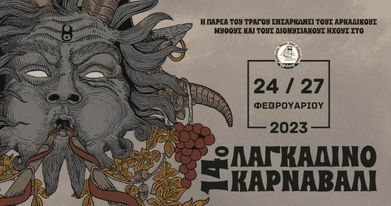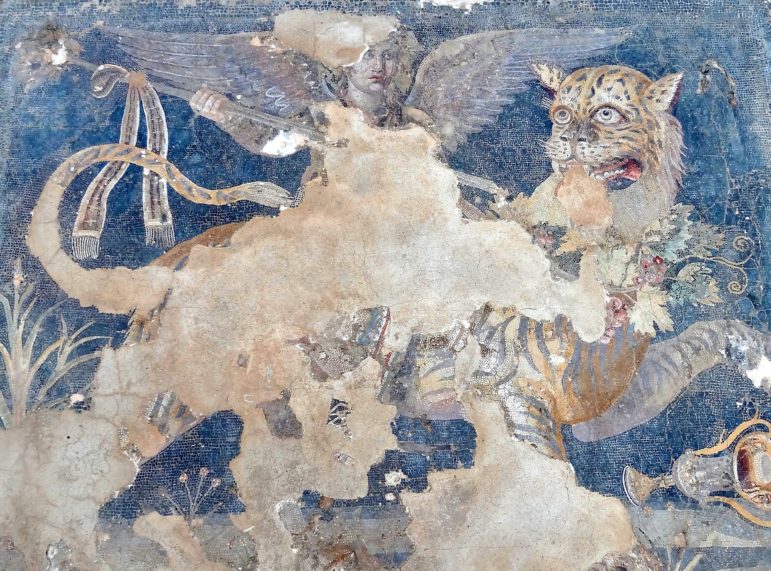
ATHENS – Apokries is Greece’s Carnival: a three-week period of feasting and costumed festivities. Just like Carnival in other parts of the world, it kicks off the last week before Lent begins. The word apokries comes from αποκρία/apokria, meaning “carnival” itself originating to mean “abstinence from meat.”
Like other carnival celebrations, children dress in costumes, eat lots of candy, and participate in parades. Despite its clear connection to Christianity today, Apokries celebrations are not sanctioned by the Orthodox church, due to some of its roots with Dionysus.

Poster for “Karnavali Festival in Lagadino”
The Dionysia, a festival dedicated to Dionysus, has been celebrated for millennia
throughout Greece in honor of the God of wine, revelry, and fertility. It was traditionally a time of feasting, dancing, parades, and rituals designed to welcome springtime.
Festivities lasted for a month, and instead of dressing in silly, colorful costumes like participants do in Apokries today, women dressed as maenads, the followers of the cult of Dionysus, and men dressed as satyrs. They would also carry a thyrsus, a tall rod made of giant fennel, with a pine cone on one end, and a taenia, or ribbon, tied in a bow below the pine cone. It was a sacred symbol of fertility, hedonism, and prosperity.
Athens over time became the center of these rituals, and in fact still holds traditional Dionysia festivals around Apokries, mainly the big event, the Falliforia parade – which is, by modern sensibilities, a less family-friendly celebration than Apokries.
Falliforia means “to carry a phallus” and symbolizes the vigor of life. The parade traditionally ended the Dionysia festival month. Later in February, these parades will be hosted in Athens, Tyrnavos, and Arcadia on the days leading up to Christian Clean Monday, the first day of Lent.
Originally particularly connected to a ritual ensuring the health of the grape vines, it became a general fertility celebration of the coming of spring each year. There were two other Dionysian festivals between December and April. The festivals of Lenaia and Anthesteria were celebrated in rural communities with these same themes.
Today, Apokries parades and festivities are much tamer and celebrated widely. Apokries festivities last three weeks and are hosted in many cities, notably in Athens, Xanthi, Rethymno, and Patras.
Apokries is celebrated with a Greek twist: dirty rhymes and poetry. Rude jokes are told, and raunchy songs were sung, in the celebration parades and performances.

Thyrsus staff tied with taenia and topped with a pine cone. [Image credit: EasyVectors.com – CC BY 2.5]
The Great Dionysia was the biggest recorded festival of Dionysus in ancient Greece. Dionysus, the god of revelry, was also the god of theater, and these plays were performed in his honor. Held in Athens, this was a festival dedicated to theater. The best playwrights from across Greece would be invited to perform three tragedies and a satyr (or satire) play; and later a comedy, as well.
Originally lasting three days, and quickly escalating to six, Great Dionysia was held for at least five hundred years, though records differ. Plays were performed all day, six days in a row: tragedies, satires, and later, comedies. This festival began in the 6th century BC when the first award was given for best actor in a tragedy. That actor was named Thespis, from which we derive the term “thespian” for an actor today.
Apokries takes elements from the Great Dionysia festival as well, as Apokries parades have skits and musical performances. Awards were given for best actor, playwright, tragedy, and comedy on the final day of the Great Dionysia. The final day was also the day of planning for the next year’s festival when playwrights would be invited back, or new playwrights were chosen.

A Hellenistic Greek mosaic depicting Dionysos as a winged daemon riding on a tiger, from the House of Dionysos at Delos in the South Aegean region of Greece, late 2nd century BC, Archaeological Museum of Delos [Public Domain]
Many participants and audience members would come from thousands of miles away. It is estimated that up to 15,000 people attended the Great Dionysia yearly.
Dionysus’ rites were also opportunities for catharsis. Two of Dionysus’ epithets played an important role in his festivals. Ελευθερευς/Eleuthereus meant “he who liberates,” and Λυσιος/Lisios means “he who brings solutions.”
Masked participation in a rite of pure freedom was a chance for people to express
themselves fully, with limited consequences, and it was thought that large-scale hedonist
celebrations like this led to greater order and productivity in the coming spring.
The Orthodox church doesn’t participate officially in Apokries celebrations but the spirits of the maenads and the satyrs are alive and well in the corners of Greece and Dionysus’ celebrations remain strong.
The Wild Hunt is not responsible for links to external content.
To join a conversation on this post:
Visit our The Wild Hunt subreddit! Point your favorite browser to https://www.reddit.com/r/The_Wild_Hunt_News/, then click “JOIN”. Make sure to click the bell, too, to be notified of new articles posted to our subreddit.